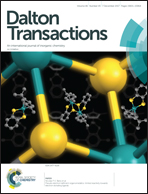Abstract
The reactivity of [PtX2(Me2phen)] complexes (X = Cl, Br, I; Me2phen = 2,9-dimethyl-1,10-phenanthroline) with terminal alkynes has been investigated. Although the dichlorido species [PtCl2(Me2phen)] exhibits negligible reactivity, the bromido and iodido derivatives lead in short time to the formation of five-coordinate Pt(II) complexes of the type [PtX2(Me2phen)(η2-CH![[triple bond, length as m-dash]](https://www.rsc.org/images/entities/char_e002.gif) CR)] (X = Br, I; R = Ph, n-Bu), in equilibrium with the starting reagents. Similar to analogous complexes with simple acetylene, the five coordinate species can also undergo dissociation of an halido ligand and formation of the transient square-planar cationic species [PtX(Me2phen)(η2-CH
CR)] (X = Br, I; R = Ph, n-Bu), in equilibrium with the starting reagents. Similar to analogous complexes with simple acetylene, the five coordinate species can also undergo dissociation of an halido ligand and formation of the transient square-planar cationic species [PtX(Me2phen)(η2-CH![[triple bond, length as m-dash]](https://www.rsc.org/images/entities/char_e002.gif) CR)]+. This latter can further evolve to give an unusual, sparingly soluble square planar product where the former terminal alkyne is converted into a :C
CR)]+. This latter can further evolve to give an unusual, sparingly soluble square planar product where the former terminal alkyne is converted into a :C![[double bond, length as m-dash]](https://www.rsc.org/images/entities/char_e001.gif) C(H)(R) moiety with the α-carbon bridging the Pt(II) core with one of the two N-donors of coordinated Me2phen. The final product [PtX2{κ2-N,C-(Z)-
C(H)(R) moiety with the α-carbon bridging the Pt(II) core with one of the two N-donors of coordinated Me2phen. The final product [PtX2{κ2-N,C-(Z)-![[N with combining low line]](https://www.rsc.org/images/entities/char_004e_0332.gif) 1–N10–
1–N10–![[C with combining low line]](https://www.rsc.org/images/entities/char_0043_0332.gif)
![[double bond, length as m-dash]](https://www.rsc.org/images/entities/char_e001.gif) C(H)(R)}] (N1–N10 = 2,9-dimethyl-1,10-phenanthroline; X = Br, I) contains a Pt–N–C–C–N–C six-membered chelate ring in a square planar Pt(II) coordination environment.
C(H)(R)}] (N1–N10 = 2,9-dimethyl-1,10-phenanthroline; X = Br, I) contains a Pt–N–C–C–N–C six-membered chelate ring in a square planar Pt(II) coordination environment.
![Graphical abstract: Insertion of terminal alkyne into Pt–N bond of the square planar [PtI2(Me2phen)] complex](/en/Image/Get?imageInfo.ImageType=GA&imageInfo.ImageIdentifier.ManuscriptID=C7DT03644B&imageInfo.ImageIdentifier.Year=2017)


 Please wait while we load your content...
Please wait while we load your content...